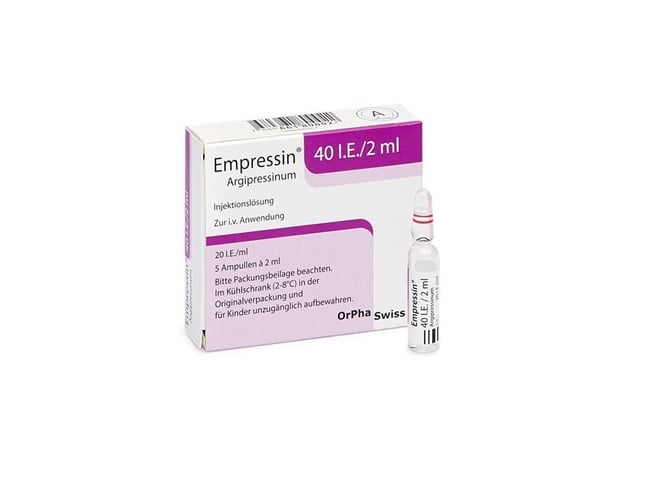

ЭМПРЕССИН 40 МЕ/2 мл КОНЦЕНТРАТ ДЛЯ ПРИГОТОВЛЕНИЯ РАСТВОРА ДЛЯ ПЕРФУЗИИ

Спросите врача о рецепте на ЭМПРЕССИН 40 МЕ/2 мл КОНЦЕНТРАТ ДЛЯ ПРИГОТОВЛЕНИЯ РАСТВОРА ДЛЯ ПЕРФУЗИИ

Инструкция по применению ЭМПРЕССИН 40 МЕ/2 мл КОНЦЕНТРАТ ДЛЯ ПРИГОТОВЛЕНИЯ РАСТВОРА ДЛЯ ПЕРФУЗИИ
Введение
Инструкция: информация для пользователя
Эмпрессин 40 МЕ/2 мл концентрат для раствора для инфузии
аргипрессина
Прочитайте внимательно всю инструкцию перед началом использования этого лекарства, поскольку она содержит важную информацию для вас.
- Сохраните эту инструкцию, поскольку вам может потребоваться прочитать ее снова.
- Если у вас есть какие-либо вопросы, проконсультируйтесь с вашим врачом или фармацевтом.
- Это лекарство было назначено только вам, и не давайте его другим людям, даже если у них такие же симптомы, как у вас, поскольку оно может нанести им вред.
- Если вы испытываете побочные эффекты, проконсультируйтесь с вашим врачом или фармацевтом, даже если это побочные эффекты, которые не указаны в этой инструкции. См. раздел 4.
Содержание инструкции
- Что такое Эмпрессин и для чего он используется
- Что вам нужно знать перед началом использования Эмпрессина
- Как использовать Эмпрессин
- Возможные побочные эффекты
- Хранение Эмпрессина
- Содержание упаковки и дополнительная информация
1. Что такое Эмпрессин и для чего он используется
Эмпрессин - это искусственно произведенное активное вещество, эквивалентное естественному гормону вазопрессину. Он регулирует гидроэлектролитный баланс в организме и снижает выведение мочи. Эмпрессин используется при септическом шоке, когда другие методы, подходящие для достижения желаемых значений артериального давления, установленных врачом, не дали результата.
2. Что вам нужно знать перед началом использования Эмпрессина
Не используйте Эмпрессин:
- если вы аллергичны к аргипрессине или к любому другому компоненту этого лекарства (указанному в разделе 6).
Предостережения и меры предосторожности
Необходимо принять особые меры предосторожности при использовании Эмпрессина:
- если он используется для повышения артериального давления при шоке после использования других методов. Администрирование должно проводиться под строгим контролем жизненно важных показателей.
- если он используется у пациентов с сердечно-сосудистыми заболеваниями.
- если он вводится пациентам с эпилепсией, мигренью, астмой, сердечной недостаточностью или любым состоянием, при котором быстрое увеличение экстрацеллюлярной жидкости может представлять опасность для организма.
- если у пациента хроническая нефрит.
Дети и подростки
Использование Эмпрессина у детей и новорожденных противопоказано.
Другие лекарства и Эмпрессин
Эмпрессин должен использоваться с осторожностью в сочетании с карбамазепином, хлорпропамидом, клофибратом, мочевиной, флудрокортизоном или трициклическими антидепрессантами, поскольку эти препараты могут усиливать эффект Эмпрессина. Эмпрессин должен использоваться с осторожностью в сочетании с демеклоциклином, норадреналином, литием, гепарином или алкоголем, поскольку эти вещества могут снижать его эффекты. Совместное использование Эмпрессина с лекарствами, влияющими на артериальное давление, может усиливать или снижать повышение артериального давления, вызванное Эмпрессином. Сообщите вашему врачу или фармацевту, если вы принимаете или недавно принимали любое другое лекарство, даже если это препараты без рецепта.
Использование Эмпрессина с продуктами питания и напитками
Эмпрессин не должен использоваться в сочетании с алкоголем.
Беременность и лактация
Эмпрессин может вызывать маточные сокращения и повышение внутриутробного давления во время беременности и может снижать маточное кровообращение. Эмпрессин не должен использоваться во время беременности, если это не абсолютно необходимо.
Неизвестно, передается ли Эмпрессин в грудное молоко.
Не рекомендуется использовать Эмпрессин во время беременности и лактации.
Проконсультируйтесь с вашим врачом или фармацевтом перед использованием любого лекарства.
Вождение и использование машин
Не проводились исследования влияния на способность управлять транспортными средствами или работать с машинами.
Важная информация о некоторых вспомогательных веществах Эмпрессина
Это лекарство содержит менее 1 ммоль натрия (23 мг) на дозу, что эквивалентно "практически не содержит натрия".
3. Как использовать Эмпрессин
Эмпрессин будет введен врачом.
Эмпрессин используется только в дополнение к традиционному лечению. Первоначально вводятся 0,01 МЕ Эмпрессина в минуту путем инфузии. Эта доза может быть увеличена каждые 15-20 минут до 0,03 МЕ Эмпрессина в минуту. Более высокие дозы используются только в случае экстренной необходимости.
Эмпрессин вводится в виде длительной инфузии и должен быть разбавлен физиологическим раствором.
Использование у детей и подростков
Эмпрессин использовался для лечения определенных состояний шока у детей, младенцев и новорожденных в отделениях интенсивной терапии и во время операций. Не рекомендуется использовать Эмпрессин для этой показания у детей и новорожденных.
Если вы использовали больше Эмпрессина, чем должны
Это лекарство будет введено врачом. Если вы считаете, что получили слишком высокую дозу этого лекарства, немедленно обратитесь к вашему врачу.
Если вы прервали лечение Эмпрессином
Отмена лечения этим лекарством должна проводиться постепенно, то есть не следует внезапно прекращать лечение. Если вы считаете, что использование лекарства было прекращено слишком рано, немедленно обратитесь к вашему врачу. Если у вас есть какие-либо другие вопросы об использовании этого лекарства, проконсультируйтесь с вашим врачом или фармацевтом.
4. Возможные побочные эффекты
Как и все лекарства, это лекарство может вызывать побочные эффекты, хотя не все люди испытывают их.
Частые (могут затронуть до 1 из 10 пациентов):
- анормальный сердечный ритм
- давление в груди
- нарушения кровообращения в миокарде, кишечнике или кончиках пальцев
- периферическое сужение кровеносных сосудов
- отмирание тканей
- спазмы
- бледность вокруг рта
- отмирание кожных тканей
Редкие (могут затронуть до 1 из 100 пациентов):
- низкий уровень натрия в крови
- дрожь
- головокружение
- головная боль
- снижение сердечного выброса
- потенциально смертельное изменение сердечного ритма
- сердечная остановка
- затруднение дыхания, вызванное сужением дыхательных путей
- тошнота
- рвота
- вздутие
- отмирание кишечных тканей
- потливость
- кожная сыпь
- изменения определенных показателей анализа крови
Редкие (могут затронуть до 1 из 1000 пациентов):
- тяжелая аллергическая реакция, потенциально смертельная
Неизвестные (частота не может быть оценена из доступных данных):
- гипергидратация
- диабетическая инсипидус после отмены лечения.
Сообщение о побочных эффектах
Если вы испытываете любой побочный эффект, проконсультируйтесь с вашим врачом или фармацевтом, даже если это возможные побочные эффекты, которые не указаны в этой инструкции. Вы также можете сообщить об этом напрямую через систему мониторинга безопасности лекарственных средств: www.notificaRAM.es. Сообщая о побочных эффектах, вы можете внести свой вклад в предоставление более полной информации о безопасности этого лекарства.
5. Хранение Эмпрессина
Храните это лекарство в недоступном для детей месте.
Храните в холодильнике (2°C - 8°C).
Не используйте это лекарство после истечения срока годности, указанного на этикетке и упаковке. Срок годности - последний день месяца, указанного.
После открытия разбавьте и используйте продукт немедленно.
Лекарства не должны выбрасываться в канализацию или мусор. Спросите вашего фармацевта, как утилизировать упаковку и лекарства, которые вам больше не нужны. Таким образом, вы поможете защитить окружающую среду.
6. Содержание упаковки и дополнительная информация
Состав Эмпрессина
Активное вещество - аргипрессина.
Одна ампула с 2 мл концентрата для раствора для инфузии содержит ацетат аргипрессины в количестве, соответствующем 40 МЕ аргипрессины (что эквивалентно 133 микрограммам).
Другие вспомогательные вещества - хлорид натрия, уксусная кислота для регулирования pH и вода для инъекций.
Внешний вид продукта и содержание упаковки
Эмпрессин - это прозрачный и бесцветный концентрат для раствора для инфузии.
Каждая упаковка содержит 5 или 10 ампул.
Возможно, не все размеры упаковок будут продаваться.
Владелец разрешения на продажу
Orpha-Devel Handels und Vertriebs GmbH
Wintergasse 85/1B
3002 Пуркерсдорф
Австрия
Вы можете запросить дополнительную информацию о этом лекарстве, обратившись к местному представителю владельца разрешения на продажу:
AOP Orphan Pharmaceuticals Iberia S.L.U.
улица Колквиде, 6, здание Присма - Портал 2, 1-й этаж
28231, Лас-Росас, Мадрид
Испания
Производитель
AOP Orphan Pharmaceuticals GmbH
площадь Леопольда Унгара, 2
1190 Вена
Австрия
Это лекарство разрешено к продаже в государствах-членах Европейского экономического пространства под следующими названиями:
Австрия Эмпесин 40 МЕ/2 мл концентрат для раствора для инфузии
Бельгия Реверплег 40 МЕ/2 мл концентрат для раствора для инфузии
Болгария ???????? 40 МЕ/2 мл концентрат для раствора для инфузии
Хорватия Эмпрессин 40 МЕ/2 мл концентрат для раствора для инфузии
Чехия Эмбесин
Германия Эмпрессин 40 МЕ/2 мл концентрат для раствора для инфузии
Дания Эмпрессин
Эстония Эмбесин
Греция Эмпрессин 40 МЕ/2 мл концентрат для раствора для инфузии
Испания Эмпрессин 40 МЕ/2 мл концентрат для раствора для инфузии
Финляндия Эмпрессин 40 МЕ/2 мл концентрат для раствора для инфузии
Франция Реверплег 40 МЕ/2 мл раствор для инфузии
Венгрия Эмбесин 40 МЕ/2 мл концентрат для раствора для инфузии
Ирландия Эмбесин 40 МЕ/2 мл концентрат для раствора для инфузии
Италия Эмпрессин 40 МЕ/2 мл концентрат для раствора для инфузии
Литва Эмбесин 40 МЕ/2 мл концентрат для раствора для инфузии
Люксембург Реверплег 40 МЕ/2 мл раствор для инфузии
Латвия Эмбесин 40 МЕ/2 мл концентрат для раствора для инфузии
Нидерланды Эмпрессин 40 МЕ/2 мл концентрат для раствора для инфузии
Норвегия Эмпрессин
Польша Эмбесин
Португалия Эмпрессин, 40 МЕ/2 мл концентрат для раствора для инфузии
Румыния Реверплег 40 МЕ/2 мл концентрат для раствора для инфузии
Швеция Эмпрессин 40 МЕ/2 мл концентрат для раствора для инфузии
Словения Эмбесин 40 МЕ/2 мл концентрат для раствора для инфузии
Словакия Эмбесин 40 МЕ/2 мл концентрат для раствора для инфузии
Дата последнего обновления этой инструкции:11/2023
Эта информация предназначена только для медицинских специалистов:
Дозировка и способ введения
Лечение аргипрессиной у пациентов с гипотензией, резистентной к катехоламинам, предпочтительно начинается в первые шесть часов после начала септического шока или в течение трех часов после начала у пациентов, получающих высокие дозы катехоламинов (см. раздел 5.1 инструкции).
Аргипрессина должна вводиться путем непрерывной внутривенной инфузии в дозе 0,01 МЕ в минуту с использованием инфузионного насоса или механической инфузионной помпы. В зависимости от клинической реакции доза может быть увеличена каждые 15-20 минут до 0,03 МЕ в минуту. Для пациентов в отделениях интенсивной терапии обычно желаемое артериальное давление составляет 65-75 мм рт. ст. Аргипрессина должен использоваться только в сочетании с традиционным вазопрессорным лечением катехоламинами. Дозы выше 0,03 МЕ в минуту должны использоваться только в качестве экстренного лечения, поскольку они могут вызывать некроз кожи и кишечника и повышать риск сердечной остановки (см. раздел 4.4 инструкции). Продолжительность лечения должна выбираться в зависимости от индивидуальной клинической картины, но предпочтительно должна составлять не менее 48 часов. Лечение аргипрессиной не должно прекращаться внезапно, а должно постепенно снижаться в зависимости от клинической эволюции пациента. Общая продолжительность лечения аргипрессиной будет определяться врачом.
Приготовьте раствор для инфузии, разбавив 2 мл концентрата в 48 мл раствора хлорида натрия 9 мг/мл (0,9%) (что эквивалентно 0,8 МЕ аргипрессины на мл). Общий объем после разбавления должен составлять 50 мл.
Скорости инфузии в соответствии с рекомендуемыми дозами:
Доза Эмпрессина/мин | Доза Эмпрессина/час | Скорость инфузии |
0,01 МЕ | 0,6 МЕ | 0,75 мл/час |
0,02 МЕ | 1,2 МЕ | 1,50 мл/час |
0,03 МЕ | 1,8 МЕ | 2,25 мл/час |
Педиатрическое население
Аргипрессина использовалась для лечения шока-расширения у детей и младенцев в отделениях интенсивной терапии и во время операций. Поскольку аргипрессина по сравнению с традиционным лечением не показала улучшения выживаемости и имела более высокие показатели неблагоприятных событий, не рекомендуется ее использование у детей и младенцев.
Противопоказания
Гиперчувствительность к активному веществу или любому другому компоненту, указанному в разделе 6.1 инструкции.
Особые предостережения и меры предосторожности
Этот продукт не должен быть заменен другими лекарствами, содержащими аргипрессину с разными единицами концентрации (например, единицами давления, ЕД).
Аргипрессина не должна вводиться в виде быстрой внутривенной инъекции для лечения шока, резистентного к катехоламинам.
Аргипрессина должна вводиться только под строгим и постоянным контролем гемодинамических и органических показателей.
Лечение аргипрессиной должно начинаться только в том случае, если невозможно поддерживать достаточное перфузионное давление, несмотря на адекватную репозицию объема крови и применение вазопрессорных катехоламинов.
Аргипрессина должна использоваться с особой осторожностью у пациентов с сердечно-сосудистыми заболеваниями. Было отмечено, что введение высоких доз аргипрессины для других показаний вызывает кишечную и миокардиальную ишемию, инфаркт миокарда и кишечника и снижает перфузию в конечностях.
Очень редко аргипрессина может вызывать гипергидратацию. Необходимо своевременно распознавать первые признаки сонливости, вялости и головной боли, чтобы избежать терминальной комы и судорог.
Аргипрессина должна использоваться с осторожностью при эпилепсии, мигрени, астме, сердечной недостаточности или любом состоянии, при котором быстрое увеличение экстрацеллюлярной жидкости может представлять опасность для организма.
У педиатрического населения не было доказано, что соотношение риска и пользы является положительным. Не рекомендуется использовать аргипрессину для этой показания у детей и младенцев (см. раздел 5.1 инструкции).
- Страна регистрации
- Активное вещество
- Требуется рецептДа
- Производитель
- Информация носит справочный характер и не является медицинской рекомендацией. Перед приемом любых препаратов проконсультируйтесь с врачом. Oladoctor не несет ответственности за медицинские решения, принятые на основе этого контента.
- Аналоги ЭМПРЕССИН 40 МЕ/2 мл КОНЦЕНТРАТ ДЛЯ ПРИГОТОВЛЕНИЯ РАСТВОРА ДЛЯ ПЕРФУЗИИФорма выпуска: ОРАЛЬНЫЙ РАСТВОР/СУСПЕНЗИЯ, 360 мкг/мл десмопрессин (безводное основание)Активное вещество: ДезмопрессинПроизводитель: Laboratorio Reig Jofre, S.A.Требуется рецептФорма выпуска: СУБЛИНГВАЛЬНАЯ ТАБЛЕТКА, 120 микрограммАктивное вещество: ДезмопрессинПроизводитель: Aristo Pharma GmbhТребуется рецептФорма выпуска: СУБЛИНГВАЛЬНАЯ ТАБЛЕТКА, 240 микрограммАктивное вещество: ДезмопрессинПроизводитель: Aristo Pharma GmbhТребуется рецепт
Аналоги ЭМПРЕССИН 40 МЕ/2 мл КОНЦЕНТРАТ ДЛЯ ПРИГОТОВЛЕНИЯ РАСТВОРА ДЛЯ ПЕРФУЗИИ в других странах
Лучшие аналоги с тем же действующим веществом и терапевтическим эффектом.
Аналог ЭМПРЕССИН 40 МЕ/2 мл КОНЦЕНТРАТ ДЛЯ ПРИГОТОВЛЕНИЯ РАСТВОРА ДЛЯ ПЕРФУЗИИ в Польша
Аналог ЭМПРЕССИН 40 МЕ/2 мл КОНЦЕНТРАТ ДЛЯ ПРИГОТОВЛЕНИЯ РАСТВОРА ДЛЯ ПЕРФУЗИИ в Украина
Врачи онлайн по ЭМПРЕССИН 40 МЕ/2 мл КОНЦЕНТРАТ ДЛЯ ПРИГОТОВЛЕНИЯ РАСТВОРА ДЛЯ ПЕРФУЗИИ
Консультация по дозировке, побочным эффектам, взаимодействиям, противопоказаниям и продлению рецепта на ЭМПРЕССИН 40 МЕ/2 мл КОНЦЕНТРАТ ДЛЯ ПРИГОТОВЛЕНИЯ РАСТВОРА ДЛЯ ПЕРФУЗИИ – по решению врача и с учетом местных правил.














